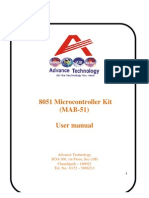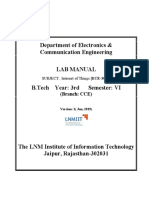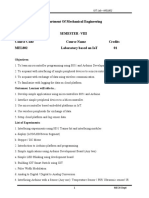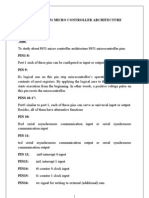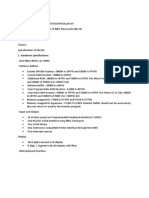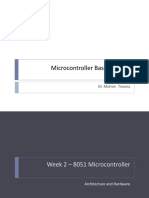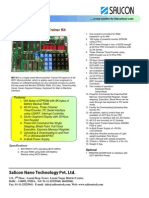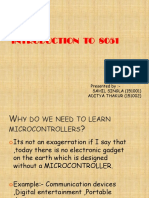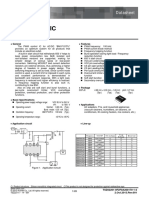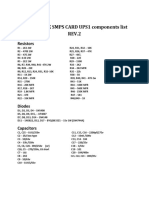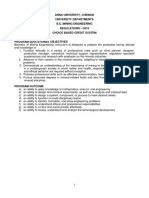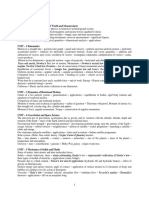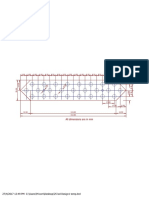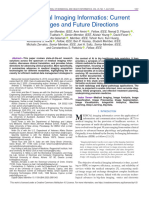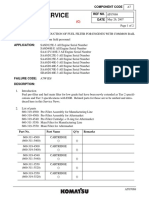MICRO CONTROLLER BOARDS
8051 Development kit
�Contents
1.
Introduction .............................................................................................................. 3
1.1 Packages....................................................................................................................... 3
1.2
- Technical or Customer Support .............................................................................. 3
2.
Specifications ............................................................................................................ 4
2.1- General Block Diagram ................................................................................................. 5
2.2 - P89V51 Controller Features......................................................................................... 6
3. Jumper & Connector Details ............................................................................................ 6
Connector Details................................................................................................................. 7
4. Power Supply ................................................................................................................... 7
5. On-board Peripherals....................................................................................................... 7
5.1 - Light Emitting Diodes ................................................................................................... 8
5.2 Digital Inputs ............................................................................................................... 8
5.3 - LCD 2x16 IN 4-BIT MODE ............................................................................................. 9
5.4 Seven Segment Display .............................................................................................. 10
5.5 - 128x64 GLCD Graphical LCD ...................................................................................... 10
5.6 - 4x4 Matrix keypad ..................................................................................................... 11
5.7 Stepper Motor........................................................................................................... 12
5.8 Relay and Buzzer Interface ....................................................................................... 13
5.9 Serial EEPROM........................................................................................................... 14
5.10 - Real Time Clock (DS1307) ........................................................................................ 14
5.11 Digital Temperature Sensor (DS18S20) .................................................................. 15
5.12- Analog-Digital Converter (SPI) .................................................................................. 16
5.13- Digital-to-Analog Converter (DAC) ........................................................................... 17
5.14 Traffic Light Controller ............................................................................................ 18
5.15 - RS-232 | Interrupt Communication ........................................................................ 18
Interrupts ........................................................................................................................... 19
6. Board Layout .................................................................................................................. 20
7. Easy Programming Steps - NXP Microcontrollers.......................................................... 21
8 Appendix ....................................................................................................................... 24
�1. Introduction
PRIMER-8051 Kit, is proposed to smooth the progress of developing and
debugging of various designs encompassing of High speed 8-bit MCU from
NXP/Dallas/Atmel. The board supports 8051 family devices with various memory and peripheral
options. It integrates on board two UARTs, LEDs, Relays, Motor Interface, keypads, an ADC input
and GLCD/LCD Display to create a stand-alone versatile test platform.
1.1 Packages
PRIMER-8051 Kit (NXP - P89V51 MCU)
Serial Port Cable
Printed User Manual
CD contains
Software (Programmers, IDE)
o
Example Programs
User Manual
1.2 - Technical or Customer Support
Post your questions :
Pantech forum
:
www.pantechsolution.net/forum
Website
:
www.pantechsolutions.net
�2. Specifications
MCU
NXP's 8051 - P89V51RD2 MCU
Memory
64K Flash Program Memory
1K SRAM Data Memory
Clock
11.0592MHz crystal for MCU | 32.768KHz RTC
On-Board
40pin-ZIF Socket | 44-pin PLCC Socket
Peripherals
8 Nos. Point LEDs (Logic Output)
8 Nos. Digital Input (Slide Switch)
4x4 Matrix Keypad
2X16 Character LCD (Background Light)
4 Nos. 7-Segment Display
2 Nos. Analog Input (Potentiometer | LM35)
Stepper Motor Driver Interface
2 Nos. of SPDT Relay
Serial EEPROM (I2C)
DS1307 RTC with Battery-Backup
2 Nos. UART(RS232)
USB 2.0 Connector ( Power Supply)
Buzzer (Alarm), Interrupts Study, Reset Button
SPI - Digital / Analog converter
2-Channel SPI Analog-Digital converter
128x64 Graphical LCD
Digital Temperature Sensor (DS18S20)
40-Pin Expansion Connector
Traffic Light Controller Modules
9-12V, AC/DC- Adaptors,
Power
Power form USB (+5V) (+3.3V, 800mA)
Connectors
D-SUB Connector (Serial Port, ISP)
40 PIN Expansion Connector
Ext Analog Input Connector
�2.1- General Block Diagram
On-Board
ISP Programmer
9V Input
+5V Reg
4 Nos
7-Segment Disp.
8 Nos.
Digital Inputs
2x16 LCD
USB
(Power supply)
EEPROM
Digital
Temperature
Relay/Motor
Driver
8051 Core
I2C RTC
Battery Backup
NXP - P89V51
4X4 Matrix
Keypad
40Pin Expansion
Connector
128x64 GLCD
On-Board Analog
Inputs
4-way Traffic
Light Module
Two
Ext Interrupts
Buzzer
LM35 Temp
Sensor
8 Nos.
Point LEDs
Supported Microcontrollers :
SOCKET1 (40-DIP)
NXP
:
P89V51Rxx
Dallas
*Atmel :
DS89C420/430/450
AT89S51/52/8252 and AT89Sxx
SOCKET2 (44-PLCC)
NXP
P89V51Rxx
Dallas
DS89C420/430/450
*Atmel :
AT89S51/52/8252 and AT89Sxx MCUs
* Dont have ISP Program Facility
2x RS232
�2.2 - P89V51 Controller Features
80C51 Central Processing Unit
5V Operating voltage from 0 to 40 MHz
64 KB of on-chip Flash program memory with ISP (In-System Programming) and
IAP (In-Application Programming)
Supports 12-clock (default) or 6-clock mode selection via software or ISP
SPI (Serial Peripheral Interface) and enhanced UART
PCA (Programmable Counter Array) with PWM and Capture/Compare functions
Four 8-bit I/O ports with three high-current Port 1 pins (16 mA each)
Three 16-bit timers/counters
Programmable Watchdog timer (WDT)
Eight interrupt sources with four priority levels
Second DPTR register
Low EMI mode (ALE inhibit)
TTL- and CMOS-compatible logic levels
Brown-out detection
Low power modes
o
Power-down mode with external interrupt wake-up
Idle mode
3. Jumper & Connector Details
Stepper / Relay
JP3
LED
JP4
Internal Supply (+5V)
External Supply(+5V)
Enable LEDs, Port (P1.16 P1.23)
Disable LEDs.
Enable Buzzer
Disable Buzzer
On-Board Analog Input(Potentiometer)
External Analog Input-1 select
On-Board Analog Input(LM35 Temp sensor)
External Analog Input-2 select
Buzzer (P0.6)
JP5
Analog I/P (POT)
JP6
Analog I/P (LM35)
JP7
�Connector Details
40-Pin Expansion Connector
CN2
P0.0
P0.2
P0.4
P0.6
P1.0
P1.2
P1.4
P1.6
VCC
GND
P2.0
P2.2
P2.4
P2.6
P3.0
P3.2
P3.4
P3.6
1
3
5
7
9
11
13
15
17
19
21
23
25
27
29
31
33
35
37
39
2
4
6
8
10
12
14
16
18
20
22
24
26
28
30
32
34
36
38
40
P0.1
P0.3
P0.5
P0.7
P1.1
P1.3
P1.5
P1.7
VCC
GND
P2.1
P2.3
P2.5
P2.7
P3.1
P3.3
P3.5
P3.7
EXPANSION CONN
4. Power Supply
The external power can be AC or DC, with a voltage between (7V/12V,1A output) at 230V AC
input. The 8051 board produces +5V using an LM7805 voltage regulator, which provides supply
to the peripherals. USB socket meant for power supply only, user can select or control power
either USB or Ext power supply through slide switch SW2.
+5V USB/EXT
SW2
Power +5V (EXT through Adaptor)
Power +5V (USB)
5. On-board Peripherals
The Development kit comes with many interfacing options
8-Nos. of Point LEDs (Digital Outputs)
8-Nos. of Digital Inputs (slide switch)
2 Lines X 16 Character LCD Display
4 Digit Seven-segment display
128x64 Graphical LCD Display
4 X 4 Matrix keypad
Stepper Motor Interface
2 Nos. Relay Interface | Buzzer
Serial EEPROM
Real Time Clock (DS1307) with battery backup
SPI-ADC | SPI DAC
Digital Temperature Sensor(DS18S20)
Traffic Light Module (Optional)
Two UART for serial communication
5.1 - Light Emitting Diodes
Light Emitting Diodes (LEDs) are the most commonly used components, usually for displaying
pins digital states.
The 8051 Kit has 8 nos., of Point LEDs, connected with port pins (P0.0 to P0.7), to make port
DIGITAL OUTPUTS
pins high LED will glow.
Point LEDs
8051 Lines
LED1
P0.0
LED2
P0.1
LED3
P0.2
LED4
P0.3
LED5
P0.4
LED6
P0.5
LED7
P0.6
LED8
P0.7
LED Selection
JP4
1
- LED Enable
- LED Disable
JP4
1
5.2 Digital Inputs
This is another simple interface, of 8-Nos. of slide switch, mainly used to give an input to the
port lines, and for some control applications also.
The 8051 Kit, slide switches (SW8 to SW27) is connected with port pins (P2.0 to P2.7), user
can give logical inputs LOW.
�DIGITAL INPUTS
Slide Switch
8051 Lines
SW8
P2.0
SW13
P2.1
SW14
P2.2
SW19
P2.3
SW20
P2.4
SW25
P2.5
SW26
P2.6
SW27
P2.7
Input Logic Selection
Make Switch Close Low
Make Switch Open High
5.3 - LCD 2x16 IN 4-BIT MODE
The 8051 Kit, have 2x16 character LCD. 7 pins are needed to create 4-bit interface; 4 data bits
(P0.4 P0.7, D4-D7), address bit (RS-P0.0), read/write bit (R/W-P0.1) and control signal (E-P0.2).
The LCD controller is a standard KS0070B or equivalent, which is a very well-known interface for
smaller character based LCDs.
8051 Education Board - Users Guide Page 25
Figure below illustrate the LCD part of the design and which pins are used for the interface. The
DATA LINES
P0.0
RW
P0.1
P0.2
D0-D3
NC
D4
P0.4
D5
P0.5
D6
P0.6
D7
P0.7
D6
D7
LED
+LED-
RS
2x16 LCD Selection
D4
D5
8051 LINES
RS
R/W
E
LCD MODULE
GND
VCC
VEE
CONTROL
LCD is powered from the 5V power supply enabled by switch SW30.
+5V
SW30
Make switch SW30 to LCD
label marking position
OFF 1
2
3
4
PWR ON/OFF
8 ON
7
6
5
7SEG
LCD
SM/RL
GLCD
�5.4 Seven Segment Display
In 8051 Kit, 4 nos. of common anode seven segment displays, The digit select lines are
connected to port pin (P3.4- P3.7) and the segment lines of seven segments LED is being
terminated at port pins (P1.0-to P1.7). All the common anode displays consume very small
amount of current.
8051 Pins
Digit - 1
P3.4
Digit 2
P3.5
Digit 3
P3.6
Digit - 4
P3.7
Seg - a
P1.0
Seg b
P1.1
Seg c
P1.2
Seg d
P1.3
Seg e
P1.4
Seg f
P1.5
Seg g
P1.6
Seg dp
P1.7
7-Segment Display
VCC
1
7-SEG
Digit - 1
1K
a
f g b
e d c
7
6
4
2
1
9
10
5
A
B
C
D
E
F
G
DP
U1
CA
seg-a
Seg-b
Seg-c
seg-d
seg-e
seg-f
seg-g
seg--dp
CA
Segment Lines
Digit select
lines
The 7-segmend display is powered from the 5V power supply enabled by switch SW30.
7 SEG DISP
Make high to - digit selection
Make low to - segment
+5V
SW30
Make switch SW30 to
7SEG label marking position
OFF 1
2
3
4
8 ON
7
6
5
7SEG
LCD
SM/RL
GLCD
PWR ON/OFF
5.5 - 128x64 GLCD Graphical LCD
The 8051 Kit is the GLCD. 14 pins are needed to create 8-bit interface; 8 data bits (P1.0 P1.7,
DB0-DB7), two chip select line P3.2(CS1) and P3.3(CS2), address bit (R/S-P3.4), read/write bit
(R/W-P3.5) and control signal (E-P3.6) and Reset (RST-P3.7). The GLCD controller is a standard
S6B0108 or equivalent, which is a very well-known interface for Graphical based LCDs.
8051 Education Board - Users Guide Page 25
Figure below illustrate the GLCD part of the design and which pins are used for the interface. The
GLCD is powered from the 5V power supply enabled by switch SW30.
�CONTROL L
LINES
LCD DATA LINES
GLCD
8051 LINES
CS1
P3.2
CS2
P3.3
RS
P3.4
R/W
P3.5
P3.6
DB0
P1.0
DB1
P1.1
DB2
P1.2
DB3
P1.3
DB4
P1.4
DB5
P1.5
DB6
P1.6
DB7
P1.7
RST
P3.7
128x64 GLCD Selection
Make switch on
SW32
SW30 - GLCD | 7-SEG position
SW32 to GLCD label marking position
GLCD
VCC
SW30
OFF
Traffic
ON
1
2
3
4
8
7
6
5
7-SEG
LCD
SM/RL
GLCD
PWR ON/OFF
*Refer datasheet for Pin Details of GLCD
5.6 - 4x4 Matrix keypad
Keypads row and column lines are arranged by matrix format. Row lines (P2.0 P2.3) and
Column lines (P2.4 to P2.7) connected directly by the port pins.
�4x4 Matrix
Lines
8051 Lines
ROW-0
P2.0
4x4 Matrix Keypad
C2
COLUMN
ROW
C1
ROW-1
P2.1
ROW-2
P2.2
ROW-4
P2.3
COLUMN-0
P2.4
COLUMN-1
P2.5
COLUMN-2
P2.6
COLUMN-3
P2.7
C3
C4
SW4
SW5
SW6
SW7
SW9
SW10
SW11
SW12
SW15
SW16
SW17
SW18
SW21
SW22
SW23
SW24
R1
R2
R3
R4
Note: While using Keypad ensure slide switches (SW8-SW27) to off
position.
5.7 Stepper Motor
The ULN2003A is a high-voltage, high-current Darlington transistor array. The device consists of
eight NPN Darlington pairs that feature high-voltage outputs with common-cathode clamp
diodes for switching inductive loads.
ULN2003 is used as a driver for port I/O lines, drivers output connected to stepper motor,
connector provided for external power supply if needed.
�P0.1
COIL-C
P0.2
COIL-D
P0.3
MOTOR_PWR
STEPPER
COIL-A
COIL-B
COIL-C
COIL-D
IN1
IN2
IN3
IN4
OUT1
OUT2
OUT3
OUT4
EN1
EN2
JP3
1
1
2
3
2- 3
MG1
COIL-B
VCC
P0.0
COIL-A
Stepper Motor PWR Select
VS
VSS
8051 Lines
STEPPER MOTOR
Stepper Motor(5V)
Internal +5V (Driver section)
VCC
SW30
OFF
ON
1
2
3
4
Make switch SW30 to SM/RL label
marking position.
8
7
6
5
7-SEG
LCD
SM/RL
GLCD
PWR ON/OFF
For Motor/relay section obtain power from on-board (internal) or external supply through
jumper JP3.
5.8 Relay and Buzzer Interface
ULN2003 is used as a driver for port I/O lines, drivers output connected to relay modules.
Connector provided for external power supply if needed. Make port pins to high, relay will
activated
A small piezoelectric buzzer on the 8051 Kit, P0.6 make the pin high, current will flow through
the buzzer and a relatively sharp, single-tone frequency will be heard.
RELAY SPDT
RELAY Power Select
8051 Lines
VCC
SW30
RELAYS | BUZZER
Relay-1
P0.4
OFF
ON
1
2
3
4
8
7
6
5
7-SEG
LCD
SM/RL
GLCD
PWR ON/OFF
Relay-2
P0.5
JP3
1
2- 3
Internal +5V (Driver section)
JP5
Buzzer
P0.6
Enable | Disable Buzzer
Note : Relay | Buzzer selection make switch SW30 to SM/RL label marking position
�For Motor/relay/buzzer section obtain power from on-board (internal) or external supply
through jumper JP3.
5.9 Serial EEPROM
The AT24C01A/02/04/08/16 provides 1024/2048/4096/8192/16384 bits of serial electrically
erasable and programmable read-only memory (EEPROM) organized as 128/256/512/1024/2048
words of 8 bits each. The device is optimized for use in many industrial and commercial
applications where low-power and low-voltage operation are essential.
Features of AT24Cxx:
Internally Organized 128 x 8 (1K), 256 x 8 (2K), 512 x 8 (4K)
2-wire Serial Interface
Bi-directional Data Transfer Protocol
100 kHz (1.8V, 2.5V, 2.7V) and 400 kHz (5V) Compatibility
Write Protect Pin for Hardware Data Protection
8-byte Page (1K, 2K), 16-byte Page (4K, 8K, 16K) Write Modes
AT 24xx
Data Retention: 100 Years.
I2C EEPROM
8051 Lines
SCL
P2.0
Serial EEPROM
AT24XX
EEPROM
8051
SDA
P2.1
SW28
Make switch SW28 to I2C label
marking position.
P2.0
P2.1
P2.2
P2.4
P2.5
P2.6
P2.7
1
2
3
4
5
6
7
8
16
15
14
13
12
11
10
9
I2C_CLK
I2C_DTA
1-WIRE
ADC_CS
ADC_SCK
ADC_SO
ADC_SI
SW DIP-8
5.10 - Real Time Clock (DS1307)
The Real Time Clock (RTC) is a set of counters for measuring time when system power is on, and
optionally when it is off. It uses little power in Power-down mode. On the 8051, the RTC can be
clocked by a separate 32.768KHz oscillator, or by a programmable prescale divider based on the
�VPB clock. Also, the RTC is powered by its own power supply pin, VBAT, which can be connected
to a battery or to the same 3.3 V supply used by the rest of the device.
Features
Measures the passage of time to maintain a calendar and clock.
Ultra Low Power design to support battery powered systems.
Provides Seconds, Minutes, Hours, Day of Month, Month, Year, Day of Week, Day of Year.
Dedicated 32kHz oscillator or programmable pre-scalar from VPB clock.
Dedicated power supply pin can be connected to a battery or to the main 5V/3V3.
DS1307
RTC
8051 Lines
SCL
P2.0
Real Time Clock
RTC
DS1307
8051
SDA
P2.1
SW28
Make switch SW28 to I2C label
marking position.
P2.0
P2.1
P2.2
P2.4
P2.5
P2.6
P2.7
1
2
3
4
5
6
7
8
16
15
14
13
12
11
10
9
I2C_CLK
I2C_DTA
1-WIRE
ADC_CS
ADC_SCK
ADC_SO
ADC_SI
SW DIP-8
5.11 Digital Temperature Sensor (DS18S20)
The DS1820 digital thermometer is well suited to environmental temperature measurement, having a
temperature range of 55C to 125C and an accuracy of +/-0.5C.
Features
Unique 1-Wire interface requires only one port pin for communication
Multi-drop capability simplifies distributed temperature sensing applications
Can be powered from data line. Power supply range is 3.0V to 5.5V
Measures temperatures from -55C to +125C (-67F to +257F)
0.5C accuracy from -10C to +85C
9-bit thermometer resolution, Converts temperature in 750ms (max.)
�8051 Lines
Dout
P2.2
DS18S20
Temp Sensor
Digital Temp Sensor
DS18S20
8051
SW28
Make switch SW28 to 1-WIRE
label marking position.
P2.0
P2.1
P2.2
P2.4
P2.5
P2.6
P2.7
1
2
3
4
5
6
7
8
16
15
14
13
12
11
10
9
I2C_CLK
I2C_DTA
1-WIRE
ADC_CS
ADC_SCK
ADC_SO
ADC_SI
SW DIP-8
5.12- Analog-Digital Converter (SPI)
The Microchip Technology Inc. MCP3202 is a successive approximation 12-bit Analog-to-Digital (A/D)
Converter with on-board sample and hold circuitry. The MCP3202 is programmable to provide a single
pseudo-differential input pair or dual single-ended inputs. Differential Nonlinearity (DNL) is specified at 1
LSB, and Integral Nonlinearity (INL) is offered in 1 LSB (MCP3202-B) and 2 LSB (MCP3202-C) versions.
Communication with the device is done using a simple serial interface compatible with the SPI protocol.
The device is capable of conversion rates of up to 100ksps at 5V and 50ksps at 2.7V.
8051 Lines
CS
P2.4
CLK
P2.5
MCP 3202
SPI - ADC
MISO
P2.6
MOSI
P2.7
SPI - ADC
ADC
MCP3202
8051
SW28
P2.0
P2.1
P2.2
Make switch SW28 to ADC label
marking position.
P2.4
P2.6
P2.5
P2.7
1
2
3
4
5
6
7
8
16
15
14
13
12
11
10
9
SW DIP-8
Analog Inputs Select
I2C_CLK
I2C_DTA
1-WIRE
ADC_CS
ADC_SCK
ADC_SO
ADC_SI
�ADC Select
ADC Inputs
Header
LM35
CH0
JP7
POT (R19)
CH1
JP6
ADC Select
1
- On-Board LM35
- External ADC I/P1
- On-Board POT(R19)
- External ADC I/P2
5.13- Digital-to-Analog Converter (DAC)
DAC Features
The Microchip Technology Inc. MCP492X are 2.7 5.5V, low-power, low DNL, 12-Bit Digital-to-Analog
Converters (DACs) with optional 2x buffered output and SPI interface.
The MCP492X are DACs that provide high accuracy and low noise performance for industrial applications
where calibration or compensation of signals (such as temperature, pressure and humidity) are required.
Features
12-Bit Resolution
0.2 LSB DNL (typ), 2 LSB INL (typ)
Single or Dual Channel
SPI Interface with 20 MHz Clock Support
Simultaneous Latching of the Dual DACs w/LDAC
Fast Settling Time of 4.5 s
Selectable Unity or 2x Gain Output
450 kHz Multiplier Mode
External VREF Input
Extended Temperature Range: -40C to +125C
MCP 2491
SPI - DAC
8051 Lines
CS
P3.5
CLK
P3.6
MOSI
P3.7
Note :
SPI - DAC
8051
Measure DAC output at J2 PTB connector.
DAC
MCP2491
�5.14 Traffic Light Controller
Traffic light controller section consists of 12 Nos. point leds are arranged by 4Lanes. Each lane
has Go(Green), Listen(Yellow) and Stop(Red) LED is being placed. Each LED has provided for
current limiting resistor to limit the current flows to the LEDs.
LAN
Direction
8051 Lines
NORTH
P3.2
D8-Stop
P3.3
D9-Listen
P3.4
D10-Go
P3.5
D11-Stop
P3.6
D12-Listen
P3.7
D13-Go
P1.0
D14-Stop
P1.1
D15-Listen
P1.2
D16-Go
P1.3
D17-Stop
P1.4
D18-Listen
P1.5
D19-Go
WEST
SOUTH
EAST
Note
LEDs
Traffic Light Controller
GO
330E
LISTEN
330E
STOP
LANE
NORTH
330E
Make high to - LED On
Make low to LED Off
LANE
EAST
LANE
WEST
SW32
GLCD
LANE
SOUTH
Traffic
: Make SW32 to Traffic label marking position
5.15 - RS-232 | Interrupt Communication
RS-232 communication enables point-to-point data transfer. It is commonly used in data
acquisition applications, for the transfer of data between the microcontroller and a PC.
The voltage levels of a microcontroller and PC are not directly compatible with those of RS-232, a
level transition buffer such as MAX232 be used.
�ISP PGM
UART0(P1)
UART1
(P2)
UART DB-9
Connector
8051
Processor Lines
RXD0
P3.0
TXD0
P3.1
Serial Port Section
8051
RXD1
P1.2
TXD1
P1.3
MAX
3232
Note : RXD1 and TXD1 lines are only available in Maxim-Dallas Microcontrollers
DS89C4xx series.
Interrupts
Interrupts
8051 Lines
SW29 (INT0)
P3.2
DS1307
Tactile
Switch
In 8051, two external interrupts lines are terminated at (EXINT0-P3.2) and (EXINT2-P3.3).
SW31 (INT1)
P3.3
Interrupts
8051
INTR
�6. Board Layout
�7. Easy Programming Steps - NXP Microcontrollers
Software Settings
1.
Open Flashmagic ISP software
Step 0 : Go to Options Menu, then choose Advanced Options, Advanced options windows appears.
Choose Hardware Config tab, Deselect Use DTR to Control RST checkbox.
Step1 : Select Com Port E.g COM1 or COM2
Set baud rate 9600
Select Device 89V51RD2
Interface None(ISP)
Step2 : Check Erase all Flash
Step3 : Load or locate your Hex files
Step4 : Select options you want like above figure, verify, erase, security bit.
Step 5: Press Start button
�Press Hardware RST Button SW3. Now it starts, Erasing, Program & Verifying.
Dallas Microcontrollers
Hardware Settings
PGM Mode
EXE Mode
SW1
1
2
3
4
SW1
8
7
6
5
Select Dallas MCU DS89C450
1. Options Menu
Select com port and set baud rate to 9600
1
2
3
4
8
7
6
5
�2. Target Menu
1.
Open Com1at 9600
2.
Connect to Loader
We get window like this
3. File Load Flash
\Examples Code\LED Blink\Out\LEDBlink.hex
Execution Mode
Set DIPSWITCH SW1 EXE Mode
�8 Appendix
Appendix A Product Overview
Board:
8051 Primer is the main board with most of the on-chip peripherals incorporated on a single
slice.
User Selectable Jumpers
JP4 LED Selection (P0.0 P0.7)
Slide Switch SW2 For Power Supply Selection ( EXT | USB)
On-Board Interrupt Study
RTC Interface | EEPROM (P2.0 P2.1)
1-wire Digital Temperature sensor (P2.2)
SPI-Analog-Digital converter (P2.4 P2.7)
8 Different Slide Switch
(P2.0 P2.7)
7-segment display (Digit P3.4-P3.7) | Data Lines (P1.0 P1.7)
Keypad Interface (Pulled Up switches
P2.0 P2.7)
Buzzer Interface
P0.6
Relay Interface
P0.4 | P0.5
Stepper Motor
P0.0 P0.3
LCD Operates on 4-Bit Mode
Control Lines
(P0.0 P0.2)
Data Lines
(P0.4 P0.7)
GLCD Interface
Control Lines
(P3.2 P3.7)
Data Lines
(P1.0 P1.7)
Content Details:
Sample Codes of all Peripherals in \Example\Extra\.. folder
Experiments solved and provided in \Example\.. folder
Software (Evaluation | Non-Commercial Products)
SMPS Adaptor | USB for Power Supply
Datasheets and Reference articles relevant to the product
Trouble Shooting
It is not advised to connect or disconnect any external devices which are not recommended
by the product reference manual.
It is risky to connect power supply not preferred by the reference user manual
Disconnecting or Removing ICs on a Powered ON kit is void.
In case of any malfunction in the product, please let us know.
This Page Intentionally left Blank
�Did you enjoy the read?
Pantech solutions creates information
packed technical documents like this one every
month. And our website is a rich and trusted
resource used by a vibrant online community of
more than 1,00,000 members from organization of
all shapes and sizes.
�What do we sell?
Our
products
range
from
Various
Microcontroller development boards, DSP Boards,
FPGA/CPLD boards, Communication Kits, Power
electronics, Basic electronics, Robotics, Sensors,
Electronic components and much more . Our goal is
to make finding the parts and information you need
easier and affordable so you can create awesome
projects and training from Basic to Cutting edge
technology.





